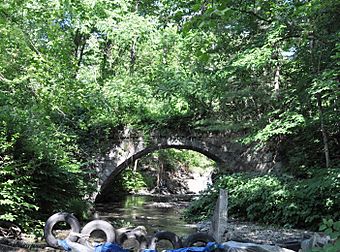East Putney Brook Stone Arch Bridge facts for kids
Quick facts for kids |
|
|
East Putney Brook Stone Arch Bridge
|
|
 |
|
| Location | Spans East Putney Brook off River Rd., East Putney, Vermont |
|---|---|
| Area | less than one acre |
| Built | 1902 |
| Built by | James Otis Follett |
| Architectural style | Masonry arch |
| NRHP reference No. | 76000149 |
| Added to NRHP | December 12, 1976 |
The East Putney Brook Stone Arch Bridge is a really old and special stone bridge in eastern Putney, Vermont. It was built way back in 1902. This bridge is quite rare because not many stone bridges were built in Vermont during the 1900s.
A talented farmer and builder named James Otis Follett from Townshend constructed this bridge. It was added to the U.S. National Register of Historic Places in 1976, which means it's an important historical site. The bridge is now just west of River Road, which it used to carry cars over.
Contents
Discover the East Putney Brook Stone Arch Bridge
Where is This Cool Bridge?
The East Putney Brook Stone Arch Bridge is in the eastern part of Putney. It's about 4 miles (6.4 km) northeast of the main village. The East Putney Brook flows from west to east, heading towards the Connecticut River. The river is only about 0.25 miles (0.40 km) away.
This old stone bridge stands a little bit upstream from where the road is now. It was bypassed around 1965, so cars don't drive on it anymore. The modern road now crosses the stream using a metal culvert. There's also another old stone arch bridge nearby, built in the 1800s for the Boston and Maine Railroad.
What Does the Bridge Look Like?
This bridge has a single arch, meaning it's one big curve over the water. The arch spans about 30 feet (9.1 m) across the stream. It rises about 11 feet (3.4 m) above the usual water level. The roadbed on top is about 16.5 feet (5.0 m) wide. This is only wide enough for one modern car lane.
Strong stone walls, called wing walls, stick out from all sides of the arch. The bridge is made from granite blocks and slabs. These stones are different shapes and sizes. They are held together with mortar in an uneven pattern. The spaces above the arch are filled with more granite blocks and rubble. On top of that, there used to be a gravel road surface.
Who Built This Amazing Bridge?
The East Putney Brook Stone Arch Bridge was built in 1902 by James Otis Follett. He was a builder from Townshend. This bridge was the first of seven bridges and culverts he built for the town of Putney.
Follett's bridges, including this one, are special. They show amazing stone craftsmanship from a time when most new bridges were being made from iron and steel. It's rare to find so many well-built stone bridges from that period in one area.



